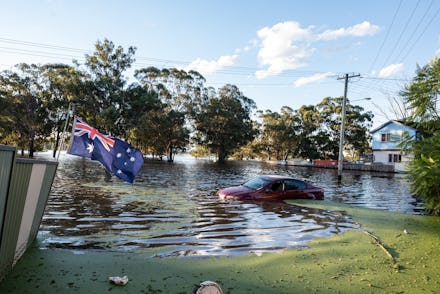After devastating floods, Australians could soon be dealing with a "plague" of deadly spiders

EasternAustralia has been getting hammered by torrential rain and flooding for the better part of a week now, resulting in tens of thousands of people being forced to leave their homes. Making matters worse, some new eight-legged residents have apparently moved in and claimed squatter's rights. Residents in the flood-ravaged state of New South Wales may soon have to contend with deadly funnel-web spiders seeking higher and dryer ground in people's homes.
Tim Faulkner, director of the Australian Reptile Park, told News.Com.Au that current weather conditions — particularly the combination of humid weather and extensive floodwaters — are creating a perfect storm for swarms of the venomous spiders to appear. “Not only are we seeing increased movement due to humidity, but we’re already seeing a plague of ground-dwelling spiders searching for higher ground, out of the floodwaters,” Faulkner said.
It's not uncommon for funnel-web spiders to pop their creepy little heads out of the woodwork following a rainstorm. They tend to be attracted to the warm, humid conditions — which is also why Australians regularly spot them in swimming pools. But in the wake of the seemingly endless rainstorms that have hovered over eastern Australia for the last week, the spiders — which can't climb on smooth surfaces and are typically more ground-bound than most of the arachnid family — are expected to be out in even greater numbers. “They have been forced out of their habitat and are seeking refuge in dryer areas,” Faulkner said. “Unfortunately, this could mean that they’ll be finding their way into residential homes very shortly.”
Some people have already documented hundreds of insects crawling around in their homes following the storms — but not all of them are cause for serious concern. While any spider is enough to elicit a shriek, most of them are harmless. Funnel-web spiders, though, are no joke. These spiders can grow to be about two inches long — and while they aren't great climbers and don't jump, they are capable of moving incredibly fast and have made a habit of setting up shop in piles of clothes or inside shoes. That kind of sneaky presence can lead to the exact interaction you don’t want with a funnel-web spider, which carries a venom that’s quite toxic to humans. Bites from the funnel-web spider can cause severe, rapidly progressing symptoms, like facial paresthesias, vomiting, and shortness of breath.
At least 13 people have died at the hands of the spiders — but those cases were all recorded prior to the discovery of an anti-venom in 1981. There have been no known deaths since then, but treatment does need to be applied quickly, within a few hours of the bite, to be effective. With many roads still blocked off throughout New South Wales as a result of flooding, getting care could become a challenge.
Research suggests that while the venom in funnel-web spiders is particularly dangerous in humans, the arachnids don't actually go out of their way to hurt people. That may not come as much comfort to the Australians who may be sharing living space with the spiders in the coming days. But, much like the thousands of humans who have been pushed from their homes by the floods, the spiders are just trying to survive the storms. The extreme weather caused by climate change really does impact everyone, regardless of how many legs you have.